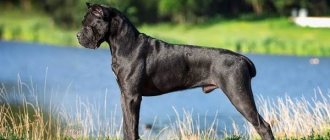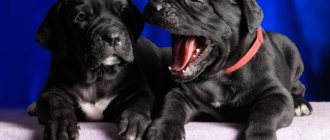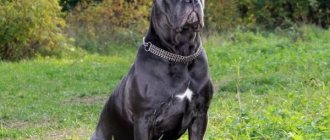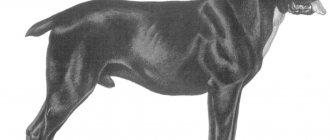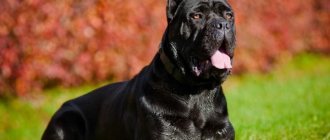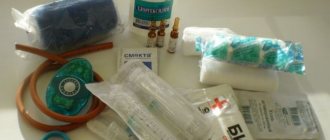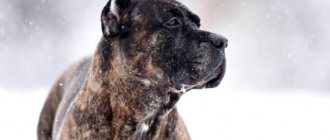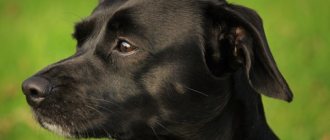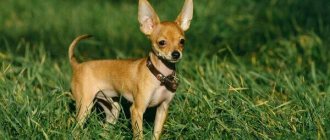The Cane Corso is a dog breed that is officially registered recently, but is actually one of the oldest. Presumably it came from dogs used in gladiator fights, but this did not affect their character. The Cane Corso has long served people: guarding property, protecting it, helping in the field and hunting. This is a fairly large dog, with a menacing and impressive appearance. In the 21st century, it has become a popular pet. This is explained by the unusual good nature and devotion of the representatives of the breed, as well as unpretentiousness and ease of care. But before you get a Cane Corso puppy, you need to study the characteristics of these dogs, their advantages and disadvantages.
- Head
- Education and training of the Cane Corso
- Health
Breed traits
Breed traits (on a 5-point scale)
| Cane Corso | |||
| Activity | in the house | 3.6 | |
| on the street | 4.2 | ||
| Obedience | training | 3 | |
| strangers | 1 | ||
| Domination | in family | 2.5 | |
| over dogs | 2.9 | ||
| Defending your territory | from people | 3 | |
| from dogs | 3.8 | ||
| Sociability | in family | 4 | |
| with strangers | 1.3 | ||
| with dogs | 3 | ||
| Concentration | in family | 2.5 | |
| in front of strangers | 2.1 | ||
| with dogs | 2 | ||
| Aggressiveness | in family | 1 | |
| to strangers | 5 | ||
| to the dogs | 5 | ||
| to cats | 3 | ||
| Family behavior | calmness | 3.2 | |
| demand for affection | 2 | ||
| excitability | 2.5 | ||
| playfulness | 2 | ||
| excessive barking | 1.7 | ||
| behavioral breakdowns | 3.7 | ||
| Tolerance for children | up to 4 years | 2.9 | |
| over 4 years old | 3.2 | ||
| Institutional use | watchman | 3.8 | |
| bodyguard | 4.5 | ||
This breed is often compared to the following dog breeds: Rottweiler, German Shepherd, American Staffordshire Terrier, Labrador Retriever, Doberman Pinscher.
In the photo the Cane Corso looks impressive and menacing:
Cane Corso
Cane Corso
Breed characteristics and character
Representatives of the breed have an exquisite appearance - glossy dark, brindle or brown fur, a muscular body, and possibly small white areas on the chest, legs or face.
You can verify this by looking at the photo of the Cane Corso . The character of these dogs is no less impressive. Any of its shortcomings are associated only with errors in upbringing, but from birth the dog has the following advantages:
- affectionate and kind attitude towards the owner, the ability to guess his mood;
- Cane Corso is a dog ideal for keeping in a house where there are children. Here the shepherd's origin plays a role - the dog believes that the owner's family is a herd that needs to be shepherded and protected;
— the disposition of the breed’s representatives fully corresponds to stereotypes about the Italian temperament. At first glance, the dog is imposing, even lazy, but it likes outdoor games or any other active activities;
— the guarding abilities of the Cane Corso are at the highest level. She will treat unfamiliar guests without expressed aggression, but with wary attention.
Cane Corso - the national pride of Italy
Cane Corso: general characteristics of the breed
The Cane Corso is a large dog that was bred in Italy. Here the breed has become a national treasure. The name is translated from Italian: cane - dog, and corso - yard, that is, “a dog for guarding the yard.”
Cane Corsos are truly the best watchdogs. They handle security, protection, vigilantly monitor the safety of all family members and will not allow strangers into the territory. And thanks to their high intelligence, loyalty and calm disposition, they are obedient and easy to train.
To better understand these dogs, you need to study the main characteristics:
- have good protective qualities, which are inherent at the genetic level and do not require development;
- outwardly they look impressive, seem imposing, but in fact they are kind, playful and cheerful;
- they love children very much, they will never offend them, they will protect and look after them;
- they are good-natured and affectionate with family members, but they are wary of strangers, although they are not the first to show aggression;
- balanced, calm character, attack only at the owner’s command or in response to a threat;
- strong, resilient, need good physical activity;
- they are trying to dominate, so they are not suitable for a weak-willed, weak owner;
- They need the attention of the owner and do not tolerate living in an enclosure or on a chain.
| Quality | Characteristic |
| weight | females 40-45 kg, males 45-50 kg |
| height | females 60-64 cm, males 64-68 cm |
| life expectancy | 9-11 years |
| aggressiveness | average |
| activity | high |
| training | light |
| need for care | low |
| intelligence | high |
| attitude towards loneliness | can't stand it |
| health | good |
Judging by the photo, this dog is capable of becoming a devoted friend and reliable protector:
A serious guy
Appearance of Cane Corso
Advantages of the Cane Corso breed
The Cane Corso is now popular all over the world. This breed is owned by famous politicians, artists, and businessmen. She has many advantages:
- appearance stately, attractive;
- guard qualities;
- devotion to the owner, selflessness in protecting him and property;
- calm, friendly character;
- does not bark in vain, gives voice only on command;
- ease of care;
- no dog smell;
- love for children;
- Thanks to his intelligence, he is easy to train.
Disadvantages of the Cane Corso breed
But the Cane Corso is not a dog for everyone. Before getting such a pet, you need to know about its disadvantages:
- impressive size;
- drooling;
- requires a lot of feed;
- tendency to dominate;
- the need for long walks;
- high price.
If a verbal description is not enough to understand what this dog looks like, you can get to know it from photographs:
Brindle Cane Corso
Impressive appearance
Health and disease of the breed
Cane Corsos often suffer from liver failure, and it develops quite quickly. Pancreatitis appears in the same way, although the exact causes are still unknown and are not always related to diet. Therefore, it is important to regularly examine the dog with a specialist and do biochemistry.
Among the congenital pathologies, there is hip dysplasia, which is generally characteristic of large breeds. This causes problems with the hind legs, so pay attention to how the dog walks and runs.
Photo: 3ghirafa.ru
Pomeranian Spitz: breed description and care (60 photos)
History of the Cane Corso breed
Cane Corso is one of the most ancient breeds and belongs to the Molosser group. Some researchers believe that other breeds originated from it. Others call the ancestors of these dogs Tibetan Great Danes. The first historical mentions of such large dogs and their images are found in documents dating back to the times of the Roman Empire.
Such dogs have served man for a long time. In addition to participating in gladiatorial battles, they guarded houses, went hunting and even took part in war. They were highly valued and expensive. In the Middle Ages, these large Italian dogs were used to herd wild animals, herd livestock, and protect homes.
For two thousand years, these dogs have not changed, they were valued and were not crossed with others. But in the 20th century, their number began to decline; the Second World War brought the breed to the brink of destruction. Only in the 80s did its revival begin. D. Nizzoli collected the remaining representatives of the breed. The Cane Corso or Italian Mastiff was officially recognized in 1996. The breed standard described its specific traits that distinguished it from other mastiffs. Now this breed is popular all over the world.
Interesting facts about the Cane Corso can be learned from the video:
Video: Cane Corso - Interesting facts about the breed
Origin story
The history is vast, because these are truly the descendants of gladiator dogs. There is a version that the first representatives of the breed appeared in the first millennium BC. They accompanied rulers on military campaigns.
After World War II, the breed almost disappeared from the face of the earth. But the Italian biologist Nizzoli took up her emergency rescue and made enormous efforts to reproduce them. The current standard was formed much later - in the 90s.
Photo: instagram.com
Description of the appearance of the Cane Corso breed
The first breed standard was drawn up back in 1984, before its recognition. Approved by the International Canine Organization in 1996. According to the standard, Cane Corso dogs must be above average height, strong, and powerful. But thanks to their proportional build, they weigh little, males weigh up to 50 kg, females – up to 45 kg. The height at the withers is 60-68 cm.
Head
The head is mastiff-shaped, large, wide, without folds. The muzzle is slightly upturned, shorter than the skull, almost square in shape. The forehead is convex, the transition from it to the muzzle is pronounced. The bridge of the nose is straight, the lobe is large and black. The upper lips hang down, covering the lower jaw. The Cane Corso has 42 large, curved teeth. The jaws are strong and easily chew through bones and thick sticks. A slight undershot is characteristic - the lower jaw protrudes forward.
The eyes are oval, medium in size, slightly convex, and should be dark. Set straight, widely spaced, eyelids close. The look is direct, intelligent, attentive. The ears are triangular, set high, and medium in size. Usually hanging, close to the muzzle, but sometimes they are docked in the shape of a triangle.
Torso
The physique is powerful, proportional, with prominent muscles. The body is slightly stretched, the length is greater than the height, it is 80-85 cm. The Cane Corso moves with grace, easily and freely. The movements are flexible, like those of a cheetah.
The neck is muscular and quite long. The chest is wide, the shoulders protrude. The withers rise slightly. The back is level, the loin is short, the croup is wide and sloping. The tail is set high and thick. According to the standard, it is stopped at the level of the 4th vertebra. The dog keeps the tail raised, but not vertically, it should not bend.
Limbs
The limbs are muscular and quite long. The front ones are set parallel, the shoulders are vertical. The thighs are long, the legs are strong. The paws are soft, wide, cat-type. Thanks to this, the dog’s movements are light, free, and runs at a sweeping trot.
The photographs allow you to understand what this dog should look like:
Photos of Cane Corso dogs
Wool
The skin is thick and fits tightly. The coat is thick, hard, shiny and smooth, up to 1 cm long. The undercoat is pronounced and protects the dog from extreme conditions. Lack of undercoat is considered a disqualifying fault, as is wavy, dull coat.
The Cane Corso has several colors allowed:
- black is the most common, classic color;
- gray or dark gray;
- brindle;
- brown.
Dogs of any color are allowed white markings on the chest, tips of the paws, and the back of the nose. Brindles and browns should have a black mask on their face. White dogs are not allowed for breeding.
This breed has different colors, which can be seen in the photo:
Cane Corso brindle color
Red Cane Corso
Gray color
Deviations from the standard
This breed began to be bred recently, with a small number of individuals. Therefore, there are still many varieties that do not meet the standard:
- Mastino is characterized by a large number of folds on the skin, drooping eyelids, and a heavy build;
- mastiffs - with long legs, a small head, a narrower muzzle;
- bullmastiff - round muzzle, many folds, drooping jowls, close-set eyes;
- boxer - shorter, squat, square body, snub-nosed muzzle, round eyes;
- Staffordshire Terrier – wedge-shaped muzzle, aggressive disposition.
Character of the Cane Corso
This dog has a calm, balanced character, he is friendly and affectionate with all family members. The Corso does not show aggression even towards strangers unless it feels threatened. But the dog clearly divides everyone into friends and foes. She is in control of the situation, always on guard. Therefore, in case of any manifestation of aggression on the part of strangers, he will fearlessly defend his owner.
Thanks to its high intelligence, the dog is able to distinguish a real threat from a game; it cannot be bribed or distracted. This is a real security guard and bodyguard who takes this matter seriously. But he will not harm a person: he will bark to scare him, he can knock him down and immobilize him, but he does not bite.
Cane Corso are the best pets for families with children. Genetically, their character includes a love for children and a parental instinct. Therefore, the dog will not harm even someone else’s child. And he allows his own to do anything, never snaps, moves carefully so as not to push him. He takes care of and shepherds little ones, and will become a loyal friend to a teenager. He also gets along well with pets, making friends not only with a dog, but also with a cat and a parrot. But be on guard with other people's dogs: with any manifestation of aggression, they can attack.
When describing the character of these pets, they also note their devotion to the owner and the whole family. For Cane Corso, emotional contact with a person is very important; they do not tolerate loneliness and changes of owners. They are also characterized by the ability to notice a person’s mood and predict desires, which can make people laugh. This dog is not intrusive, but it is very important for him to feel useful. He will happily accompany his owner and support any game. This is a kind dog, there is no jealousy, selfishness or aggression in him.
Character flaws include stubbornness and independence. The pet will follow the owner's commands, but not always right away. If raised incorrectly, the dog may strive for leadership and become uncontrollable.
An interesting video shows the character traits of Corsa:
Video: Cane Corso
Education and training of the Cane Corso
Although these dogs are naturally intelligent, they require training from an early age. You need to pay a lot of attention to obedience and discipline. It is advisable to take a general course with puppies, and after 10 months - the “Dog in the City” course. The dog will protect the property of the owner and himself, but it is better to find an instructor and train him. For successful socialization of a pet, it is necessary for it to communicate with other people and dogs from the age of 4 months. Puppies of this breed can be shy.
During training, aggressive methods or punishment should not be used. Corsas are very intelligent, they do not tolerate disrespect and can be stubborn. But these dogs quickly understand what is required of them. They love to study and are very inquisitive. If you use game training methods, you can teach your pet basic commands by 4-5 months. These are the commands “sit”, “stand”, “to me”, “place”, “no”, “near”.
You can watch the video about the features of corse training:
Video: Cane Corso breed features
Caring for Cane Corso dogs
The Cane Corso is an unpretentious pet; despite its impressive size, it lives well in a city apartment. Although, with a lack of physical activity, he will get bored and may chew on things. Therefore, you need to walk with your pet for a long time, preferably in different places, so that he gets new impressions. But until the age of two, these dogs cannot be overexerted by running and jumping, as they have a weak musculoskeletal system.
Keeping a pet is quite expensive due to its appetite, but otherwise it does not cause problems. You just need to know a few features:
- Corsas do not tolerate cold, therefore, when living in a private house in winter, they need an insulated kennel; during frosts, it is advisable to take the pet indoors;
- walk for at least 2 hours a day, and during the walk the dog should actively move and run;
- brush the coat once a week with a stiff brush, this will help get rid of dead hair, since these dogs shed all year round;
- bathe when dirty, no more than once every 1-2 months, wash paws after a walk, wipe the fur with a damp cloth;
- check the ears weekly and clean them with special means to prevent the development of inflammation; they stop at an early age;
- Give chewing bones to clean teeth;
- After eating and drinking, wipe the face with a cloth, as these dogs salivate excessively.
Health
The health of representatives of this breed is quite strong, but this depends on genetics. With good heredity and proper care, dogs live 10-12 years. But Corsas are predisposed to femoral dysplasia. It is also possible to develop other diseases:
- eversion of eyelids;
- epilepsy;
- pathologies of the thyroid gland;
- allergic reactions;
- indigestion;
- otitis.
It is necessary to carry out antiparasitic treatment of the animal regularly. Give anthelmintic drugs every 3-4 months.
Nutrition
This dog needs at least 0.5-1 kg of food per day. It depends on the weight, approximately 30-40 g per kilogram of weight. The stand for bowls should be located at chest level so that the dog does not bend over. Clean water must always be freely available.
With natural feeding, meat should be the basis of the diet. You can give bones and offal. It is important to accustom your pet to cereals, vegetables, and fermented milk products. You must cook separately; you cannot feed from your own table. It is forbidden to give smoked meats, pork, river fish, sweets, and baked goods. Additionally, vitamin and mineral supplements are recommended.
Many Cane Corso owners choose industrial food for their pet. They should be super premium or holistic with a high protein content. You need to choose food that is intended for large breeds: Belcando, Acana, Royal Canin, Purina Pro Plan, Brit Care. Dry food should not be combined with natural food.
The photographs show how much food such a large dog requires:
Dinner
Care and maintenance
Contrary to the belief that large dogs can only be kept in the local area, the Cane Corso can live perfectly well in an ordinary city apartment. Despite the love for outdoor games, the dog, if necessary, is able to lead a calm lifestyle, waiting for a walk. Moreover, in severe frosts, its undercoat is unlikely to cope with temperature regulation.
And because of the freedom-loving nature of the breed, there is absolutely no place for it on a chain. But active rest is absolutely necessary for the harmonious development of the animal. Starting from the puppy's age, the Cane Corso needs to be walked, and not in the same place, but always in different ones. A change of environment has a positive effect on the dog's nervous system.
Cane Corsos are very sensitive to their owner's mood and need his love.
This is also a great way to strengthen the relationship between pet and owner. Walks per day should last at least an hour. A dog under two years old should not be heavily jogged, as this can harm its musculoskeletal system.
Caring for the Cane Corso's coat does not take much time. It is enough to comb it a couple of times a week with a special mitten or a rubber comb. This way you will get rid of lost hair, improve the animal’s blood circulation and give pleasure. Most often, this procedure should be carried out in autumn and spring, when molting occurs.
The Cane Corso does not smell like a dog, like other dogs, but there is a problem of excessive salivation, only a towel can save you from it. You should not bathe your dog often; this procedure is performed once a month or less. You can buy special dry shampoo at the pet store.
To dry clean, spray your pet with a spray bottle or simply wipe with a cloth soaked in shampoo. After this, wipe thoroughly with a dry, warm towel.
Mother Cane Corso plays with her puppy
Carefully monitor the condition of your dog's ears. Any dirt can be carefully removed with a cotton pad without penetrating deep into the ear canal. Ideally, the ears should be clean, without any characteristic odor or discharge. If you notice that your dog is shaking his head for no apparent reason, or there is something squelching in his ears, contact your veterinarian immediately.
Dental care consists mainly of preventing tartar. To do this, the dog’s diet should contain enough solid foods, as well as tomatoes. In stores you can also find special treats for cleaning teeth.
If tartar or plaque does form, a veterinarian can remove it. The claws usually grind down on their own, but if necessary, you can use a nail clipper.
As for docking the ears and tail of a Cane Corso , much depends on the tastes of the owners. For example, some people can't stand floppy ears or complain about the tail thumping loudly when the dog is happy.
The Cane Corso is in good health, but needs daily walks and exercise.
Depending on the individual characteristics of the animal, cropped ears may or may not suit him. Here you will need to consult a specialist who will decide how to correctly position the dog’s ears. The tail is usually docked at the fourth vertebra, it can be a little longer, but in no case shorter, this would be a serious drawback.
How to buy a Cane Corso puppy
Cane Corso can only be purchased from a kennel or from professional breeders. This is a fairly rare breed, and expensive in price. There is no need to save money; for a low price you can buy a mestizo who will not have the unique character qualities of this Italian mastiff. To purchase a truly purebred dog without disqualifying defects or diseases, you need to study reviews about the owner, photos of the parents, and the conditions in which the animals are kept. The puppy must have all the documents: puppy card, pedigree, veterinary passport.
A good breeder will definitely provide information about the parents, carry out vaccinations and deworming on time. He is worried about the puppies, so after the purchase he is ready to give advice on how many times to feed them, how to raise them, and when to vaccinate them. The price of a purebred Cane Corso delirium or show class in Moscow is more than 100 thousand rubles. The cost of a pet-class puppy, which may have minor flaws that prevent it from participating in exhibitions, is less - from 40 thousand. Individuals with rare coat colors are more expensive.
It is recommended to buy a puppy at the age of 1.5-2 months. After 3 months it will be more difficult for him to get used to his new owner. When choosing, you need to pay attention not only to the price and pedigree of the parents. The following signs indicate that the puppy is healthy and without character flaws:
- he is active and playful;
- not cowardly or aggressive;
- calm, attentive look;
- moderately well-fed, but the tummy is not bloated;
- there is no discharge from the eyes, the ears are clean, without an unpleasant odor;
- the coat is smooth, shiny, without dandruff and bald patches.
The standard recommends ear and tail docking. This must be done by the breeder. But recently, many countries have abandoned cupping, considering this procedure inhumane. The tail is often docked, leaving the ears drooping.
The photo shows what puppies should look like:
Cane Corso puppies with mother
Cane Corso puppy
The video will help you understand whether it is worth buying a pet of this breed:
Video: Cane Corso
The Cane Corso is a large, strong dog. She is ideal for protection, but you should not breed her as a watchdog. This is an intelligent animal, but needs proper education, socialization and communication with the owner. In the absence of these conditions, an uncontrollable aggressive dog may grow up, which will cause many problems. Therefore, before getting this breed, you need to consider whether it will be possible to walk your pet a lot, train it and devote time.
Nutrition
When choosing between natural food and dry food, experienced owners often lean towards the second option, because Cane Corso dogs are prone to food allergies. The disadvantage of this solution is the high price of hypoallergenic feed. Pros - it’s easy to calculate the dosage; sometimes you can pamper your pet with canned food of the same brand.
Initially, you can try natural foods to check for allergies. Then you will have to spend a lot of time to create a complete and balanced diet. It is not compiled for life, but is constantly adjusted depending on the age and condition of the animal, its physical activity and even the season.
Cane Corso in the forest in autumn
New foods can be introduced to the puppy only two weeks after he has settled in the new home, and the frequency of feedings must initially be the same as at the previous place of residence. It is advisable to have equal intervals between feedings.
Cane Corso, as a fairly energetic and strong dog, needs a large amount of animal protein. It is found in meat, fish, eggs. Puppies can be fed boiled veal or rabbit.
If the animal is natural, then the menu must include porridges based on meat and other broths. For taste, you can season them with fresh herbs and vegetables. A variety of fruits and salads dressed with yogurt can serve as treats. Under no circumstances should you feed your Cane Corso pork, lard, bones, river fish, sweets, spices, or poultry skin.
